New progress and problems of Quaternary moraine dating in the Tibetan Plateau
BenXing Zheng, YongPing Shen , KeQin Jiao, XiuFeng Yin
Cold and Arid Regions Environmental and Engineering Research Institute, Chinese Academy of Sciences, Lanzhou, Gansu 730000, China
1 Introduction
In the 19thcentury, stratigraphic and geomorphic analysis methods were used to correctly interpret moraine sequence stratigraphy, and were the most effective way to reveal their chronology. Even though these various dating methods have produced a large body of data, the correct interpretation still depends on stratigraphy and geomorphology (Figure 1). For instance, the age of older boulders may be underestimated for erosion and even have a large magnitude of error. For example, in the Kunlun Pass area,Qinghai of China (Figure 2), Cuiet al.(1998) used the electron spin resonance (ESR) method and obtained an age of 710 ka for an old moraine; Chenet al.(2011) used the10Be method to date fresh surface samples of the moraine exposed by weathering in the same area, and found the age to be 40 ka. In contrast, the ages of some young moraines were overestimated. For example, in the Qilian Mountains,some modern glaciers are mixed with old bedrock blocks on the slope, so sample’s dating results cannot represent the real formation time (Shi, 2000; Shiet al., 2000, 2006).In addition, the moraine age only represents the deposit time of glacier retreat. An example would be that in the Gongga Mountains, Wanget al. (1989) and Zheng and Ma(1994) dated the last glaciation as 24–15 ka, while Owen(2005) obtained the moraine ages of 9 ka for the Hailuogou camp No. 1 and 6 ka for the south side of camp No. 2. The age data obtained by Owen (2005) can only represent the early stage of post glaciation and the warmest period of the Holocene, and the glacier retreat cannot reflect the formation time of the Hailuogou Glaciers.
Another example of underestimation is that in the Tanggula Mountains, where old moraines in the northern slope of the Taoerjiu Pass were deposited during the Tanggula Ice Age (Zheng and Jiao, 1991), and in this place Owenet al.(2005) and Wanget al.(2007) obtained dates of 181.30±15.70 ka and 105.71±4.39 ka, respectively. The terminal moraines of the outlet glacier on both sides of the Tanggula Pass was originally identified to be a penultimate glaciation (Liet al., 1986; Zheng and Jiao,1991; Jiao and Shen, 2006), while Owenet al.(2005) and Wanget al. (2007) obtained an age of 125–215 ka. Thus,only two Ice Ages occurred during the Pleistocene in the Tanggula Mountains; this result is inconsistent with the evolution history of three Ice Ages in this area. Shiet al.(2011) pointed out that there are certain differences of dating ages as compared with the results obtained by previous Chinese scholars. To address these discrepancies,further studies for evolution of the Pleistocene Ice Ages in the Tanggula Mountains are needed.
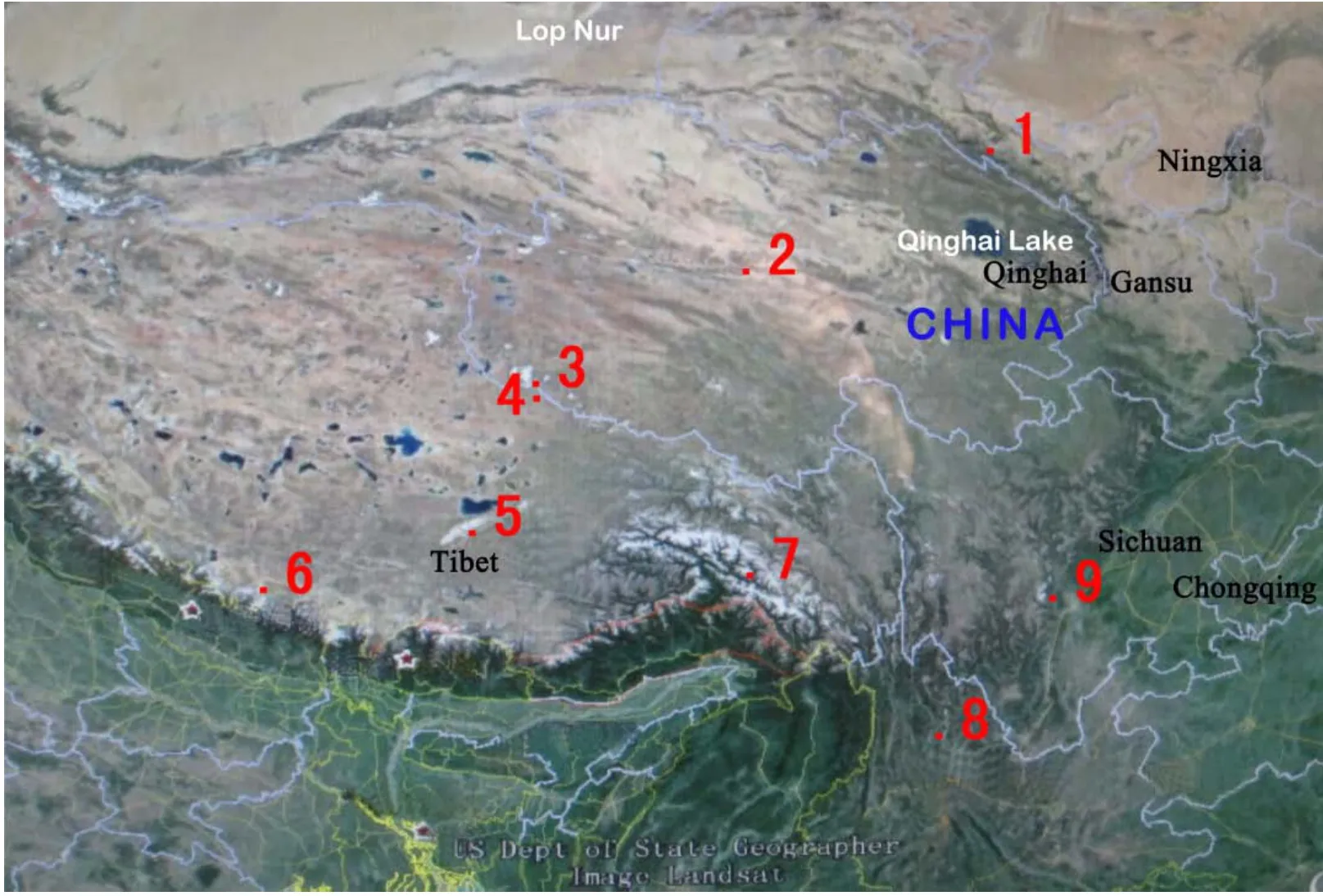
Figure 1 Quaternary moraines dating sites in this paper
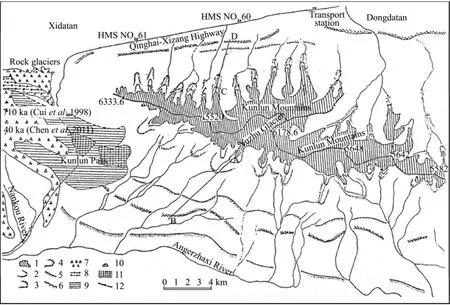
Figure 2 Distribution of Quaternary glaciers in Kunlun Pass region.
2 Stratigraphy and geomorphology methods
Before the 21thcentury, there were dating methods such as14C, thermolumninescence (TL), ESR and U series dating; the methods of stratigraphy, geomorphology and geochemistry are to divide the Quaternary into numerous glacial-interglacial cycles (Zheng and Shi, 1976;Zheng and Li, 1981; Liet al., 1986). Shi (2002) established a table of Chinese Quaternary glacial-interglacial cycles in contrast with deep sea deposit oxygen isotope stages. From the late 20thcentury to the beginning of the 21stcentury, new dating methods were used to prove the accuracy of glaciation divisions.
In the eastern Nyainqentanglha Mountains of the upper Poduzangbu River, the end moraines near the Baiyu village formed in the early or the late stage of the Baiyu Glaciation in the Last Glaciation, while older moraines near the Guxiang village belonged to the Penultimate Glaciation. Recently, the TCN10Be moraine dating method confirmed the Baiyu Glaciation age in(11.1±1.9)–(18.5±2.2) ka, and the Penultimate Glaciation age in (112.9±16.7)–(136.5±15.8) ka (Zhouet al., 2007).
3 Glacial stages
At the northern slope of Mt. Qomolangma in the Rongbu valley, Liuet al.(1962) classified the Rongbude Temple end moraines into the last glaciation. Zhenget al.(Zheng and Shi, 1976; Zheng and Li, 1981; Zheng, 1989;Zheng and Shi, 2006) argued that the Rongbude Temple end moraines (5,100 m) formed in the Neoglaciation of the Holocene, and classified the Rongbu Temple (5,000 m) and Jilong Temple end moraines (4,780 m) into two stages of the Qomolangma Ice Age in late Pleistocene. Liet al.(1983) differentiated the Rongbu Valley end moraines into the Rongbude Neoglaciation of the Holocene,the Rongbu Temple glacier age and the Jilong Temple glacier age, respectively. Zheng and Shi (2006) contrasted the Jilong Temple end moraine with the Guxiang Glaciation and judged it into the late period of the middle Pleistocene. This result is consistent with the results of Liet al. (1986) and Burbank and Kang (1991). Recently, the glacier deposits from the north slope of Mt. Qomolangma have been dated by Owenet al. (2009), and the results are as follows:
· Little ice age moraines, 1.6±0.1 ka (CRN);
· Neoglaciation moraines (corresponding to Rongbude Temple end moraine), 2.4±0.2 ka (CRN);(6.8–7.7)±0.1 ka (OSL);
· Rongbu Temple end moraines, 16.6±4.1 ka (CRN);(14.2±0.9)–(16.3±0.8) ka (OSL); the product of late glacial;
· Jilong Temple end moraines, 24.3±3.8 ka (CRN),26.5±1.6 ka (OSL); the product of the last glaciation,the equilibrium altitude fall line of 150 m;
· Dzakar moraines, 34.6±6.6 ka (CRN) or 39.4±4.1 ka(OSL), the product of MIS 3;
· Tingri moraine beside high platform, 330±29 ka(CRN); possible product in MIS 10, the relation to Nieniexiongla Ice Age will be found.
4 Some discordant dating data to the history of geomorphic development and glaciation evolution
From the 1970s to the early 21stcentury, stratigraphy and geomorphic methods were used to divide the Quaternary glaciation chronology of Mt. Tanggula. There are possibly three glaciations from the middle Pleistocene to the late Pleistocene,i.e., Tanggula, Zhajiazangbu and Bashicuo (Xu, 1981; Zheng and Li, 1981; Liet al., 1986;Xu and Li, 1986; Zheng and Jiao, 1991; Jiao and Shen,2006) or four glaciations,i.e., Baiduo, Buqu, Zhajiazangbu and Bashicuo (Puet al., 1982). These authors noted that the glaciers before penultimate glaciation were huge ice caps or piedmont glaciers, but the glaciers of the Zhajiazangbu glaciation and the Bashicuo glaciation (last glaciation) were valley glaciers. Recent data from new dating methods show that the outlet valley glacier, rising from the south slope of the Tanggula Pass, flowed out of the valley at an elevation of 4,950–5,100 m, forming a paleoglacier of about 20 km long. The valley glacier rising from the northern slope passed Bashicuo to the north and flowed into the Buqu River. On both northern and southern slopes of the Tanggula Pass, the moraine dating data of the outlet valley glacier or the compound valley glacier are different to those of the boulders of the Tanggula Ice Age huge ice cap glacier (3,000 km2) near the Taoerjiu Pass(Figures 3, 4). These boulders belong to the Tanggula glaciation, but they are dated as 105.71 ka, 175.62 ka, and 105.71–181.03 ka, which seems to be too young (Owenet al., 2005; Wanget al., 2007). The results are contradictory to the history of glaciation evolution,i.e., when the huge ice-cap glacier extend to over 100 km wide, about 3,000 km2near the Tanggula pass, there was no valley glacier in the centre of the ice-cap; when the southern slope of the pass was an outlet valley glacier during the penultimate––Zhajiazangbu glaciation, the ice-cap glacier grew to over 3,000 km2and 100 km wide (Figure 5). Recent research on the evolutionary processes of glaciers show a strong tectonic uplifting of the Qinghai-Tibet Plateau before 0.2–0.3 Ma, called the Bayiquan Movement (Zhenget al., 2012). The Altun Mountains presented a strong uplift during this period even after 0.25 Ma, consequently the Tarim Basin thoroughly separated from the Qaidam Basin (Donget al., 2011). After the Bayiquan tectonic movement, the climate in north of the Himalayas became colder and drier (Figure 6). This area includes the east of the Nyainqentanglha Mountains (Jiali County, east) in the Tibet Plateau, the southeastern Tibet and the Hengduan Mountains. The climate of forming a well-developed monsoon marine type of glacier in this region was the result of the northward movement of the Indian Ocean moisture passing through the Yalung Zangbu River gorge.This type of glacier belongs to a large scale penultimate glaciation. To the east of the Tanggula Mountain Pass there were subcontinental type glaciers, whereas to the west of the Tanggula Pass there were ultracontinental type glaciers,where the conditions did not favor glacier development(Figure 7). Therefore, the dating results are contradictory to the glaciation evolution history in this region.

Figure 3 Glacial geology in the area around Tanggula Pass. (a) Simplified geomorphic map of the Tanggula Pass showing the sites where we have obtained CRN dates on moraines (modified from Zheng and Jiao, 1991). The dates in parenthesis were undertaken by Schäfer et al. (2002). (b) View of end moraines of the Bashico Glacial Stage south of the Tanggula Pass.(c, d) Typical glacial boulders on surface of moraines deposited during the Zhajiazangbu (c: boulder PR76 and Tanggula Glaciations; d: boulder PR77). The above map is from Owen et al. (2005)
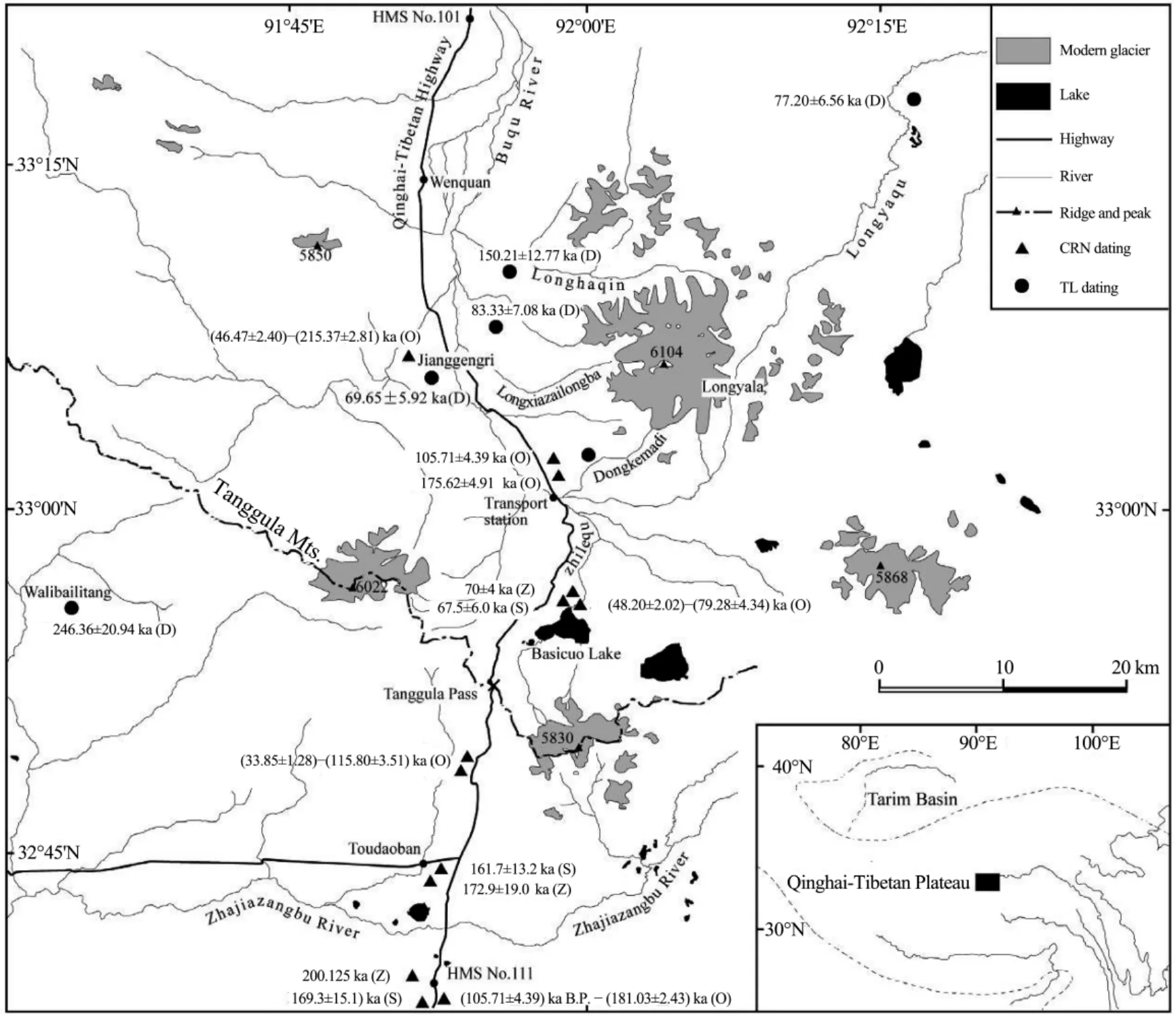
Figure 4 Study of Quaternary glacial sediments around Tanggula Pass (modified from Wang et al., 2007). O, S, D and Z stand for dating by Owen et al. (2005), Schäfer et al. (2002), Duan et al. (2005) and Zhao et al. (2002), respectively
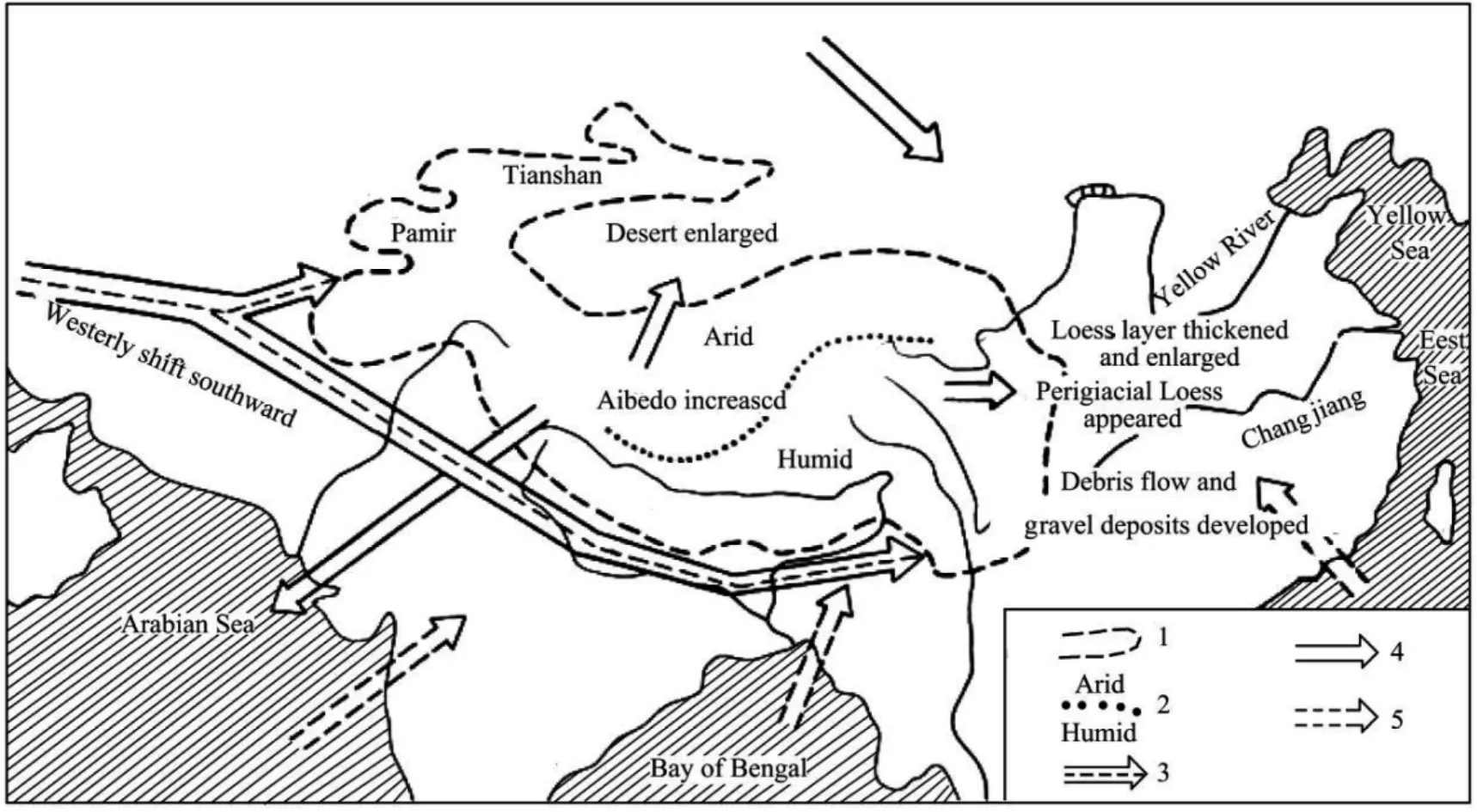
Figure 5 The cryosphere of the Tibetan Plateau and its impact on the monsoon and environment during 0.8–0.6 Ma B.P. (from Shi, 1988).(1) Plateau boundary; (2) Climatic boundary; (3) Westerly jet stream;(4) Enhanced winter monsoon; (5) Weak summer monsoon
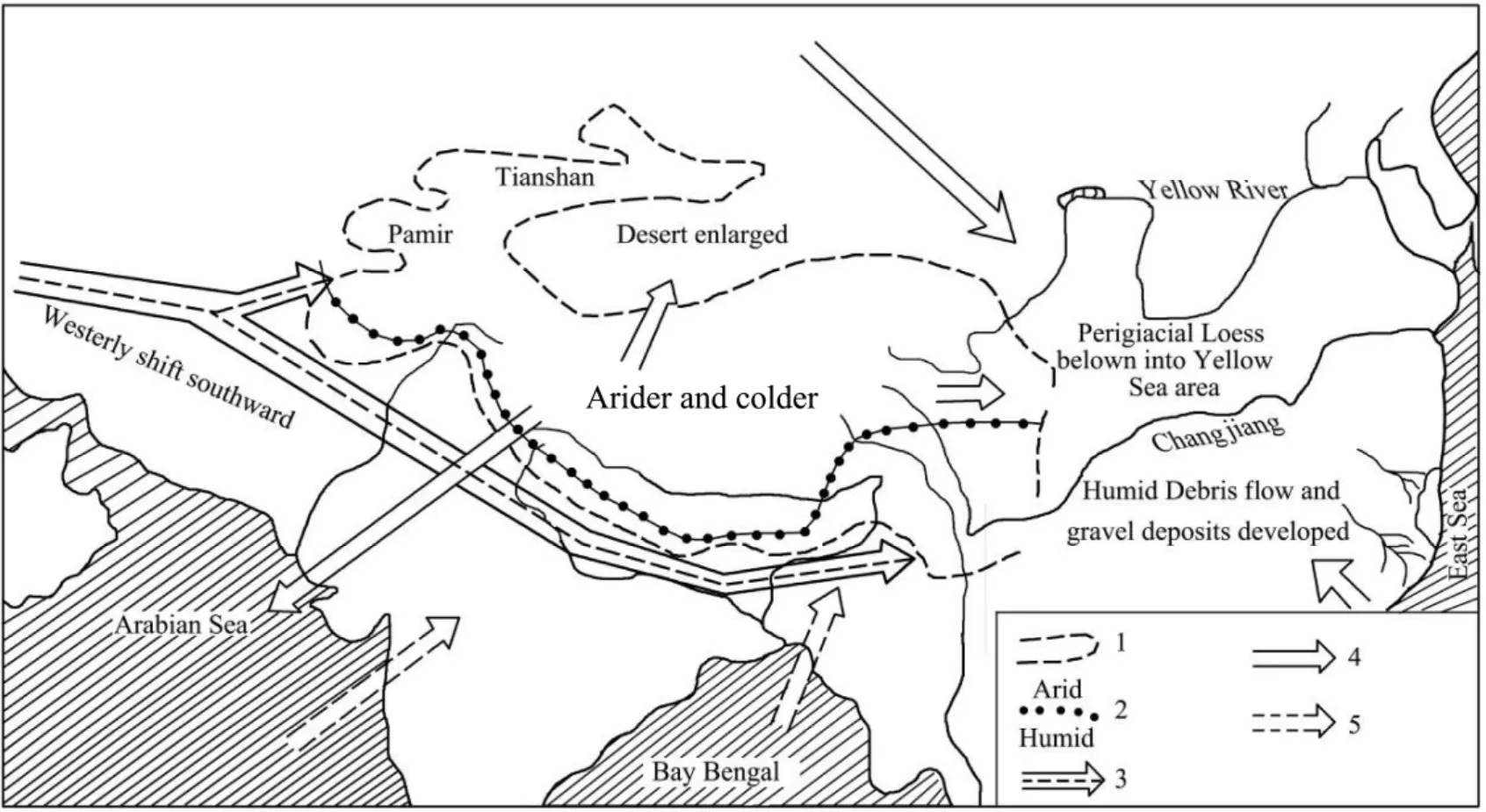
Figure 6 The cryosphere of the Tibetan Plateau and its impact on the monsoon and environment during the period after the Baiyiquan movement (0.3–0.2 Ma B.P.). 1: Plateau boundary; 2: Climatic boundary; 3: Westerly jet stream;4: Enhanced winter monsoon; 5: Weak summer monsoon

Figure 7 Quaternary uplift and glacial-interglacial cycles in the Qinghai-Tibetan Plateau
Also, the age of dated moraines can only represent the deposition age when glacier retreated, and it can’t represent the glacier forming time before the period of the glacial maximum. For example, the14C dating of organism from moraines yielded an age ranging from 24 ka to 15 ka (i.e., the last glacial maximum, LGM) in Mt.Gongga (Wanget al., 1989; Zheng and Ma, 1994). Later,Owen (2005) dated the No.1 camp moraine of Hailuogou by10Be method at about nine thousand years ago[(7.59±0.73)–(9.15±0.50) ka], belonging to the early stage of the Holocene; dated the moraines at the southern side of the No.2 camp at (3.27±0.43)–(6.27±0.47) ka,being the glacier violent retreat in the warmest period of the Holocene. These ages only represent the post glaciation times, that is, the early stage of the Holocene and the warmest period in the Holocene, can’t reflect the formation period of the Hailuogou Glacier.
5 Conclusions
The development and application of various dating methods give opportunities to us to learn the evolutionary sequence of the Quaternary glaciers, but there are huge challenges in the application of the dating data. We must identify glacier landform before sampling, and understand the process how glacier sediment being transported.
To better understand the glacial deposit process in stratigraphy and geomorphology, ideal study site and dating samples are essential, besides, advanced testing and analyzing methods are helpful to reduce dating error.At present, there are numerous dating methods, so it is imperative to collect enough samples to confirm each of those methods. Moraine dating is a powerful tool and will play a more important role in the future.
This study was supported by The State Key Science Research Programme for Global Change Research of China(Grant No. 2010CB951404) and the National Natural Science Foundation of China (Grant Nos. 41071043, 41271083).
Burbank KDW, Kang XC, 1991. Relative dating of the Quaternary moraines Rongbuk Valley Mount Everest, Tibet: Implications for an ice sheet on the Tibetan Plateau. Quaternary Research, 36(1): 1–18.
Chen YX, Li YK, Zhang M,et al., 2011. Terrestrial cosmogenic nuclide10Be exposure ages of the samples from Wangkun Till in the Kunlun Pass. Journal of Glaciology and Geocryology, 33(1): 101–109.
Cui ZJ, Wu YQ, Liu GN,et al., 1998. Records of natural exposures on the Kunlun Shan Pass of the Qinhai-Xizang Plateau. In: Shi YF (ed.).Uplift and Environmental Changes of Qinghai-Xizang (Tibetan)Plateau in Late Cenozoic. Guangdong Science and Technology Press, Guangzhou, pp. 17–80.
Dong ZB, Su ZZ, Qian GQ,et al., 2011. Aeolian Geomorphology of the Kumtagh Desert. Science Press, Beijing, pp. 1–484.
Duan ZM, Li Y, Li YL,et al., 2005. Quaternary tills at the pass of the Tanggula Mountains on the Qinghai-Tibet Plateau and their geological-environmental significance. Geology in China, 32(1): 128–134.Jiao KQ, Shen YP, 2006. Quaternary glaciations in the Tanggula range.In: Shi YF, Cui ZJ, Su Z (eds.). The Quaternary Glaciations and Environmental Variations in China. Hebei Science and Technology Publishing House, pp. 309–325.
Li BY, Wang FB, Zhang QS,et al., 1983. Quaternary Geology of Xizang (Tibet). Science Press, Beijing, pp. 1–200.
Li JJ, Zheng BX, Yang XJ,et al., 1986. Glaciers in Xizang. Science Press, Beijing, pp. 1–309.
Liu ZC, Liu ZZ, Wan FB, 1962. A comparison of the Quaternary glaciers development patterns nearby the Qomolangma Peak, Hantengri Peak and the Tuanjie Peak of Qilian Mountains. Acta Geographcia,28(1): 1–33.
Owen LA, Finkel RC, Barnard PL,et al., 2005. Climatic and topographic controls on the style and timing of the late Quaternary glaciation throughout Tibet and Himalaya defined by10Be cosmogenic radionuclide surface exposure dating. Quaternary Science Reviews,24(12–13): 1391–1411.
Owen LA, Robinson R, Benn DI,et al., 2009. Quaternary glaciation of Mount Everest. Quaternary Science Reviews, 28(15–16):1412–1433.
Pu QY, Wu XH, Qian F,et al., 1982. The Quaternary geology problem of the Tanggula Mountain region along the Qinghai-Xizang Highway. In: Professional Paper on Geology Studies of Qinghai-Xizang Plateau. Geology Press, Beijing, pp. 19–33.
Schäfer JM, Tschudi S, Zhao Z,et al., 2002. The limited influence of glaciations in Tibet on global climate over the past 170000 yr. Earth and Planetary Science Letters, 194: 287–297.
Shi YF, 1998. Evolution of the cryosphere in the Tibetan Plateau, China,and its relationship with the global change in the mid Quaternary.Journal of Glaciology and Geocryology, 20(3): 197–208.
Shi YF, 2000. Discussion on monsoon evolution in relation to uplift of the Qinghai-Xizang (Tibetan) Plateau. Formation and Evolution,Environmental Changes and Sustainable Development on Tibetan Plateau. Academic Press, Beijing, pp. 149–165.
Shi YF, 2002. A suggestion to improve the chronology of Quaternary Glaciation in China. Journal of Glaciology and Geocryology, 24(6):687–692. DOI: 10.3969/J.ISSN.1000-0240.2002.06.001.
Shi YF, Cui ZJ, Su Z, 2006. The Quaternary Glaciations and Environmental Variations in China. Hebei Science and Technology Publishing House, pp. 1–618.
Shi YF, Zhao JD, Wang J, 2011. New understanding of Quaternary Glaciations in China. Shanghai Popular Science Press, pp. 1–213.
Shi ZT, Zhang SQ, Zhou SZ,et al., 2000. Study of ESR dating of Quaternary Moraine, Qilian Mountains. Journal of Glaciology and Geocryology, 22(4): 353–357.
Wang J, Zhou SZ, Tan SL, 2007. The sequence of Quaternary Glaciation around the Tanggula Pass. Journal of Glaciology and Geocryology, 29(1): 149–156.
Wang ML, Hu FD, Li ZW, 1989. An Exploration on the Quaternary Ice Age in the region of the Gongga Mountain. In: The Collected Papers of Research for the Hengduan Mountains. Sichuan Scientific and Technologic Publishing House, Chengdu, pp. 50–68.
Xu SY, Li JJ, 1986. The Relics of Quaternary Glaciations in Tanggula Rang. In: Glaciers in Xizang. Science Press, Beijing, pp. 238–242.
Xu SY, Zhang LY, 1981. A geomorphological analysis of age and amplitude of the Tanggula Mountain upheaval. In: Studies on the Period, Amplitude and Type of the Uplift of the Qinghai-Xizang Plateau.Science Press, Beijing, pp. 64–77.
Zhao ZZ, Wu XH, Schluchter C,et al., 2002. The first determination on nuclides exposure age of Quaternary glaciers in Qinghai-Tibet Plateau. Journal of Geomechanics, 8(4): 306.
Zheng BX, 1989. The influence of Himalayan uplift on the development of Quaternary glaciers. Zeitschrift für Geomorphologie, 76:89–115.
Zheng BX, Jiao KQ, 1991. Excursion Guidebook XI Quaternary glaciations and periglaciations in the Qinghai-Xizang (Tibetan) Plateau.INQUA Congress XIII. Science Press, Beijing, pp. 1–35.
Zheng BX, Li JJ, 1981. Quaternary glaciation of the Qinghai-Xizang Plateau. In: Geological and Ecological Studies of the Qinghai-Xizang Plateau. Science Press, Beijing.
Zheng BX, Ma QH, 1994. The glacier variation climate change and the river valley development in the Holocene on the Gongga Mountains.Acta Geographica Sinica, 49: 500–508.
Zheng BX, Qu JJ, Shen YP,et al., 2012. Feathery faults formation in Kumtagh Desert: Bayiquan Teotonic Movement and its relationship among Qinghai-Tibet Plateau uplift and climate change. Journal of Glaciology and Geocryology, 24(3): 591–596.
Zheng BX, Shi YF, 1976. Discussion on Quaternary Glaciations in Mount Qomolangma Area. In: Liu TS (ed.). Report of Scientific Expedition in Mount Qomolongma Region (1966–1968), Quaternary Geology. Science Press, Beijing, pp. 29–62.
Zheng BX, Shi YF, 2006. Quaternary glaciations in the Himalayas. In:The Quaternary Glaciations and Environmental Variations in China.Hebei Science and Technology Publishing House.
Zhou SZ, Xu LB, Patrick MC,et al., 2007. Cosmogenic10Be dating of Guxiang and Baiyu Glaciations. Chinese Science Bulletin, 52(10):1387–1393.
 Sciences in Cold and Arid Regions2014年3期
Sciences in Cold and Arid Regions2014年3期
- Sciences in Cold and Arid Regions的其它文章
- Identification and evaluation of desertification reversal in China: indicators and methods review
- Effects of sand burial on dune plants: a review
- Effects of fertilization on population density and productivity of herbaceous plants in desert steppe
- Water sources of plants and groundwater in typical ecosystems in the lower reaches of the Heihe River Basin
- Modeling tropical river runoff: A time dependent approach
- Climate transformation to warm-humid and its effect on river runoff in the source region of the Yellow River
